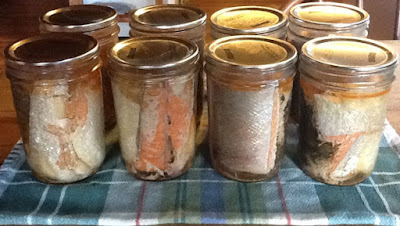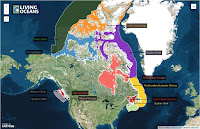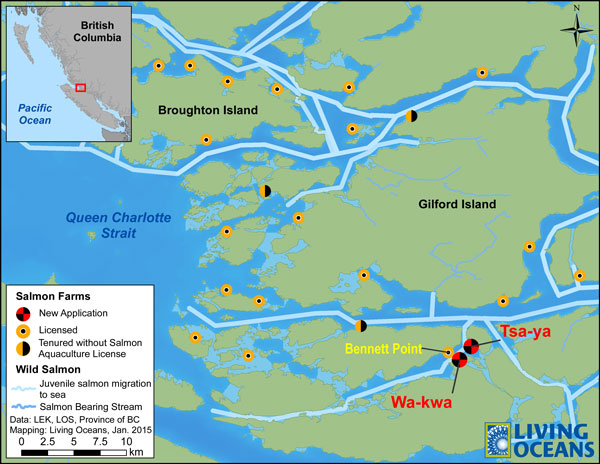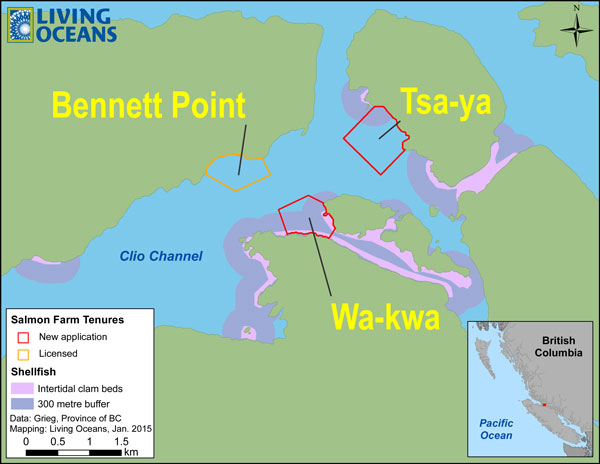By Karen Wristen
Living Oceans’ 2015 efforts to Clear the Coast of marine debris brought in an amazing five metric tonnes of debris, mainly composed of plastics of Japanese origin. Last year, working on the same Cape Scott beaches, we picked up 2.67 tonnes of plastic from all over the world, with Japanese-labelled items comprising about one-third of the total.
In an effort to put a dent in the enormous volume of plastic waste that is washing up on northern Vancouver Island shores, this year we intensified our efforts with more volunteers on the ground and more ground covered. We organized two major expeditions: the first returned to Sea Otter Cove aboard Paul Ross’s
Samphire, and the second ventured into new territory for us in the Scott Islands, from a base camp in San Josef Bay.
Sea Otter Cove, August 17-24
It was delightful to return to Sea Otter Cove—it is such a pretty and secure cove and the weather was full-on summer. Sea otters plied the water daily for food, seemingly undisturbed by our presence; and while wolves and bears were evident, they kept out of sight. Dozens of different birds soared all around us as we worked. The kelp beds at the entrance to the Cove look as healthy and abundant as ever.
 |
| A raft of sea otters. Photo: Kari Watkins |
Most of our crew camped on shore this year, while I stayed on
Samphire to be on hand to get meals for everyone. It was quite the trick, feeding such a large crew from a tiny galley but we worked it in shifts and our volunteers were either very polite or actually impressed by the quality of the food we were able to turn out.
I’d like to say we found Sea Otter Cove clean, after all the work we did last year, but not so: we managed to fill five lift bags with nearly one tonne of debris! We recovered fishnet entangled in hundreds of metres of line that was painstakingly untangled to create bags for lifting large and unwieldy chunks of plastic, while purchased bags made of re-purposed fishnets and others designed specifically for helicopter lifts were used for most of the debris.
We hiked an easy 40-minute trail north over to Lowrie Bay on two days, because there was just so much debris there. Lowrie is a beautiful, deep sandy beach that is wide open to the Pacific, with rocky outcrops on which the waves break dramatically—a surfer’s paradise. It’s also so long that we had to establish two consolidation sites: some of the debris there was far too heavy to move long distances. Large, dense plastic pallets and the ever-present net balls are really challenging to move over soft sand! We packaged everything ready for lifting and left it high above the high tide line.
 |
| Fish floats wrapped in re-purposed fish net on the beach at Lowrie Bay. |
To the south, the outer beaches of San Josef Bay that can’t be accessed from the Cape Scott trail head were easy to get to from Sea Otter Cove. A marked trail crosses level ground and not 15 minutes’ walking brings you out to the Bay. Last year, a passing family of boaters cleared a stretch of this beach for us and we picked up the debris. This year, you’d be hard-pressed to know it had ever been cleaned: I actually lost count of the number of bags we filled there, and there were multiple strings of fishing floats, tires, plastic jugs and the like that weren’t bagged, but just lifted on a rope.
 |
| Clear the Coast volunteers with fishing floats collected from San Josef Bay. |
The beach at San Jo was so heavily covered in logs that it was tricky to find an area to consolidate everything for the lift—we either had to carry everything over the pickup-sticks pileup or chance leaving it where the highest tides might still reach. We opted for the latter, but I won’t do that again: when we came back to get it at the end of the next expedition, it was half-buried in a load of seaweed and sand and getting it out was a dirty, smelly proposition!
I missed the voyage to and from Sea Otter on
Samphire, as I’d elected to drive to San Jo so that we’d have a vehicle in case of emergency. Our science volunteer, Garth Covernton, accompanied me and so the pair of us had to be shuttled around to San Jo’s inner beach to hike out to the truck. Paul Ross had nearly flipped his inflatable in the surf the day he came to pick us up, so we were cautious about a drop-off point. We chose to land at the second beach, knowing nothing about the trail between there and the trail head. Let’s just say I was not inclined to argue with B.C. Parks’ characterization of it as “treacherous” when I later read the sign at the trail head!
It’s a bone-jarring ride on a logging road from the Cape Scott trail head back to Port Hardy and it’s wise to keep one’s fluids up by stopping at the Scarlet Ibis in Holberg along the way. Legendary fish and chips and the first cold beer to be found outside the Park.
Lanz and Cox Island Provincial Park, September 5-8
Our second expedition was planned to attack the innermost of the Scott Islands group. Last year, our helicopter pilot had told us that the islands were choked with debris and she was right! This trip had to be done by helicopter because the waters are so dangerous and we needed large numbers of volunteers to do the work in a single day—or so we thought.
 |
| Karen Wristen among the jagged rocks on the beach at Cox Island. |
We established a base camp on the beach at San Jo Bay, with 18 of us in tents and a cook tent rigged up over a helpfully large root ball buried in the sand. I have to mention the 45-minute trail down which we’d had to bring enough food and supplies for 18 people for four days—my partner Jasper and I using wheelbarrow and dolly, and volunteer Michael Neate using his bicycle trailer sans bicycle (they’re not allowed in the park) barely managed it. Sure, it’s wheelchair accessible; it’s also one of those trails that gets longer and hillier every time you do it!
We hired West Coast Helicopters to take us out to the Island in teams of four or five people per beach. We’d hoped to be able to hop from beach to beach and do a couple each, but found so much debris that we could have spent more than the hours we had just cleaning the three we chose to start with. We also found that, at low tide and in calm weather, there would have been no problem camping overnight on at least two of the beaches, so we could have planned a more extended cleanup.
I worked with Terry and Eric Grantner and Michael Neate on the first beach on which we landed a crew. Within three hours, we had bagged up four lift bags, one net bag and a huge string of floats. The helicopter returned with its hook on and removed our bags in two lifts. At this point, Mother Nature began interfering with our plans. When the helicopter returned, there was no hook in sight and we knew something was wrong. We climbed aboard and learned from our pilot, Paul Smith, that the weather was closing in fast and worse—he’d found his spare fuel contaminated with water. Facing two uncertainties, he’d elected to get the crews out as fast as possible. Looking at the ugly, dark cloud closing in from the north as we headed back to San Jo, I was happy for his good judgment!
Unfortunately, we’d been unable to communicate with one another on the VHF radios we’d brought—the headlands between the beaches were too much of a barrier. Each crew could communicate with the helicopter when it was within range, but that didn’t give the other two crews enough warning to be able to secure their bags to shore to await a later pickup. We were all concerned that a high tide would float them out, posing a hazard to navigation and to wildlife that might become entangled in the ropes securing the bags to one another. We waited uneasily through a drizzly night to find out what the morning would bring.
The next day must have dawned—the fog got brighter, at least—and I was certainly not expecting the helicopter that landed about 10:30 with the news that we could try to lift out some of the bags from the first expedition. Lanz and Cox were out of the question, however; a blank wall of sea fog obscured them from view.
Jodie, Michael and I were off to tend the lifts within minutes. We managed to get everything out of San Jo and all but one bag from Sea Otter before the pilot had to leave for another job. That left the Lowrie, Sea Otter and Cox Island loads stranded; we were out of budget and out of time with this crew of volunteers.
I have to break the continuity here to recall some acts of exceptional heroism. One of the net bags that left Sea Otter Cove looked like trouble from the minute it left the beach—the load of irregularly shaped plastics had become hung up in the net and wasn’t sitting in the bottom of it the way it should. That would place undue stress on the net and I feared it would tear. It didn’t; but what did happen was that the load fell into the bottom of the net and snapped the rope from which it was hanging just as the helicopter passed over our campsite!
Taking nothing away from the effort that everyone put into this expedition, I have to say that Marten Sims deserves special mention for getting into the water in San Jo Bay on a cool September day to attach a line to the bag. Nigel Marshall, too; when the line Marten was carrying proved too short for the job, he waded in behind Marten and between them, they recovered the bag intact. He, Wesley Piatocka and Cassy Bergeron packed the load out to the bins at the trailhead using the wheelbarrow and trailer, in two trips that left them exhausted. Kudos to them and to everyone who helped plan the recovery, warm up the swimmers and break down the load for packing out!
We packed up camp on the morning of September 8th. Returning to Sointula, I called Coast Guard to report a potential hazard to navigation, put out an urgent call for funding and a media release and began appealing to the public for help. And that’s where the amazing things started happening...
The Third Expedition
First, the Vancouver Aquarium called to say they had a little bit of tsunami debris funding left and they could help. On the strength of that and some generous donations from our supporters, I booked a helicopter and debris bins for the weekend of Sept 19th and 20th. Michael Neate and Jodie Bergeron volunteered to join me, as we expected to find our bags scattered by the tides and needing some man-handling to get them into position for lifting.
Just before I left, the Canadian Wildlife Service called to say they could purchase some helicopter time for us. And while I was up island waiting on the weather (again), the Cape Scott Wind farm called to say they would donate two hours’ of helicopter time. And then the sun came out, against all predictions.
We still ended up having to do the work over two days, when Saturday dawned quite soggy. The ceiling was high enough despite the rain, so we flew from West Coast’s Port McNeill base to our first stop near Hanson’s Lagoon, where I’d agreed to look for the kit of a shipwrecked sailor who had contacted me that week. He’d provided co-ordinates, so it took no time to locate the wreck and salvage his dry bags. The wreckage was too large to contemplate moving, so we stowed it above the high tide line.
 |
| Shipwrecked sailboat near Hanson's Lagoon. |
From there, we hooked up the bags at Lowrie Bay with no difficulty. The helicopter was a while coming back, though; and when it did, our pilot said the ceiling was lowering and so he’d hooked up the load at Sea Otter himself and dropped it; we were heading home. It was the lowest flying I ever hope to do, but very instructive: we were able to take a good, close look at all the pocket beaches south of Cape Scott and every one is full of debris!
Sunday, the weather forecast changed dramatically and we were off—driving to San Jo Bay one more time. The pilot needed to sling fuel out to San Jo in order to be sure of having enough for the job, so we could not fly with him. We arranged to meet at the San Jo parking lot—if we were needed. Mike Aldersey, the base manager, was flying this job himself and he felt it would be most efficient if he went out alone and did the hookup. We were there as backup, if it proved we were needed to move the bags about.
It did turn out that we were needed—after the first load, Mike landed to explain he had to have someone on the ground to help with the rest. But his helicopter was showing a warning light and we’d have to wait for another one from McNeill. That meant another pilot, who could be with Mike in the helicopter while they flew a load in—something he can’t legally do with passengers. We had to decide between doing two trips—one for passengers and one for debris—or letting them handle it themselves. Naturally we opted for the most efficient approach, although not without regret that we wouldn’t see Cox Island again this year.
 |
| Marine debris in a bin. |
We stayed to see two more 30-yard bins filled with the remaining debris, making four in total that we’d recovered. To give you an idea of the volume that represents, I figure I could park two of my Honda Civics in a bin lengthwise, and open the doors right up without touching the sides. They’re about eight feet tall. Stacked two and two, they’d be about the size of a small two-storey house. It’s amazing to think we recovered that much with the work of about 20 people over seven collection days; more amazing still to realize that there is easily 20 times that much still out there on Cox, Lanz and Vancouver Islands.
Jodie Bergeron, Michael Neate, Ross Weaver and I sorted that last load for recyclables at the 7-Mile Landfill the next day. Thanks to the Regional District of Mount Waddington, we were not required to pay the tipping fees and received an accurate, weigh-scale total for our labours.





















